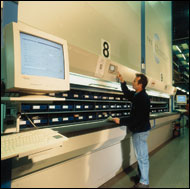 The principles of lean production are being applied to all areas of manufacturing and warehousing operations. The storage and retrieval of small parts is no exception. Richard Price, business development manager at Kardex, explains how stores are becoming leaner. It is difficult to have anything to do with modern manufacturing without coming into contact with the philosophy of lean manufacturing. The basic ideas of single-piece flow, continuous improvement and the relentless elimination of waste that have made companies, such as the major automotive OEMs, the industrial powerhouses they are today, are being used to some degree by every manufacturer interested in remaining competitive. These fundamental principles are an enlightening tool when evaluating options for parts storage too.
The principles of lean production are being applied to all areas of manufacturing and warehousing operations. The storage and retrieval of small parts is no exception. Richard Price, business development manager at Kardex, explains how stores are becoming leaner. It is difficult to have anything to do with modern manufacturing without coming into contact with the philosophy of lean manufacturing. The basic ideas of single-piece flow, continuous improvement and the relentless elimination of waste that have made companies, such as the major automotive OEMs, the industrial powerhouses they are today, are being used to some degree by every manufacturer interested in remaining competitive. These fundamental principles are an enlightening tool when evaluating options for parts storage too.
Modern automated storage and handling systems dramatically increase the storage density of small parts. These systems – exemplified by the Kardex Shuttle lift-based units and Industriever vertical carousel systems – deliver their contents quickly and accurately direct to the operator. They also integrate seamlessly with inventory management and manufacturing execution systems to provide accurate information flows right across the business. Together, these benefits can be applied to all the Seven Wastes that lean manufacturing efforts seek to target.
In traditional manual storage systems operators can travel tens of kilometres every day in the process of picking and storing items. The goods-to-man principle that underlies all automated storage and retrieval systems is one of the biggest productivity drivers from this technology, saving time, improving ergonomics and allowing workers to operate in well laid out, comfortable workspaces.
Unnecessary processing is a waste that plagues traditional warehousing operations. To ensure adequate inventory accuracy in manual storage systems, parts may be scanned or manually keyed into multiple inventory management systems several times during the process of delivery, storage and retrieval. Automated handling systems with full software integration reduce this repetition by seamlessly allocating appropriate storage positions for incoming stock as it is manufactured or delivered. Incoming material can then simply be scanned into these spaces, with any mismatches automatically detected and flagged.
Excessive transportation of goods is an important source of waste in applications where work in progress moves to an intermediate storage point before completion. The extremely high storage densities provided by automated units delivers dramatic improvements here, allowing work in progress, components and consumables to be stored much closer or even in some cases on the production line, meaning less time spent moving components needlessly about.
Any time that a worker spends waiting is time lost and money wasted. For storage solutions that feed manufacturing processes, this creates an imperative to get the right parts to the line on time, every time. The speed and accuracy of an automated system delivers clear benefits here. For warehousing and distribution operations, waiting can be reduced by taking previously sequential operations and making them parallel. Using linked sets of automated shuttles or carousels, for example, operated with the latest generation of sequencing and control software, such as the Kardex PowerPick 5000 suite, allows machines to automatically pre-select the next item in a pick list while the operator is still picking the previous one. Picking productivity can be improved up to 8-fold using this approach.
Quality problems can arise in storage and retrieval operations as much as in any other part of manufacturing. Picking the wrong product for shipment to the customer or incorporation into production is a costly and time wasting process. Automated storage and retrieval systems provide a significant improvement in picking accuracy by offering only the correct products to the operator. The basic Shuttle and Industriever systems are equipped with pick-to-light systems which indicate the exact storage location for even higher accuracy. For the very highest levels of picking accuracy secure systems, like the Kardex Sentinel, physically restrict access to all but the required product. This system provides perfect ‘poka yoke’ – mistake proofing – during picking operations and also improves security for high value parts utilising a concept analogous to vending machines to achieve discrete issue.
The final two wastes – unnecessary inventory and overproduction – might seem to be outside the scope of storage technology, but today’s system can help here too. The visibility of inventory provided by integrated, automated retrieval systems is much higher than that offered in any manual storage technique. This means that ‘safety factors’ built into inventory plans to cover inaccuracy and loss can be reduced or eliminated and that production plans can be tied much more closely to real needs, using a digital Kanban approach.
Applied in the right way, automated retrieval systems make the perfect complement to organisation-wide lean manufacturing efforts. By simultaneously freeing up space, increasing productivity and driving down all sources of waste, they provide a powerful, flexible platform upon which to build a sustainable competitive advantage.
Kardex
Tel: 08702 422224
email: info@kardex.co.uk
www.kardex.co.uk




Comments are closed.